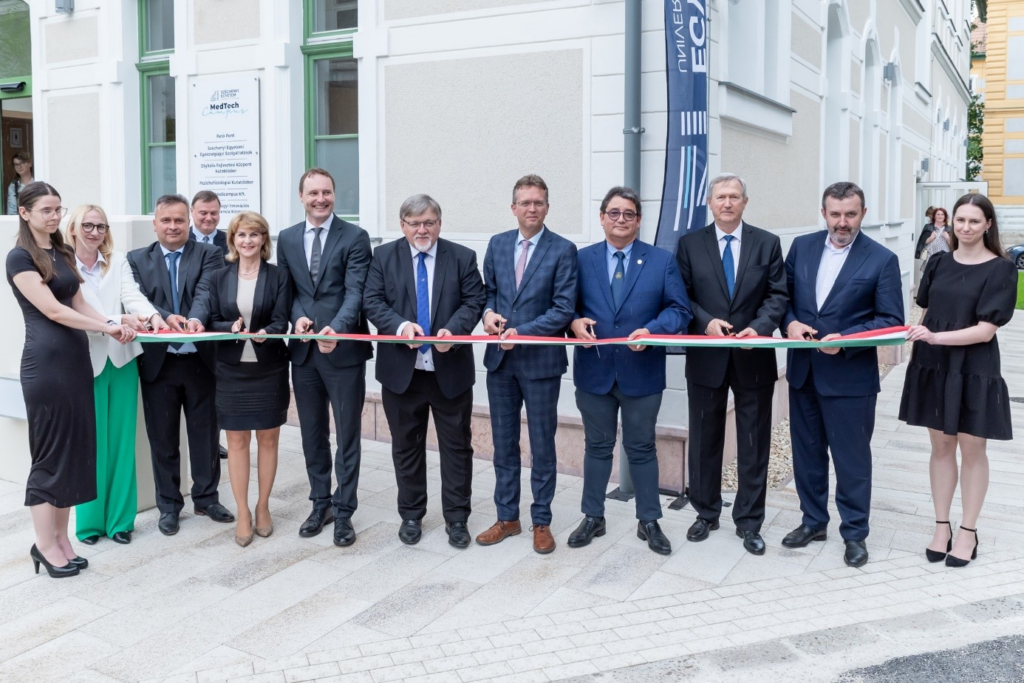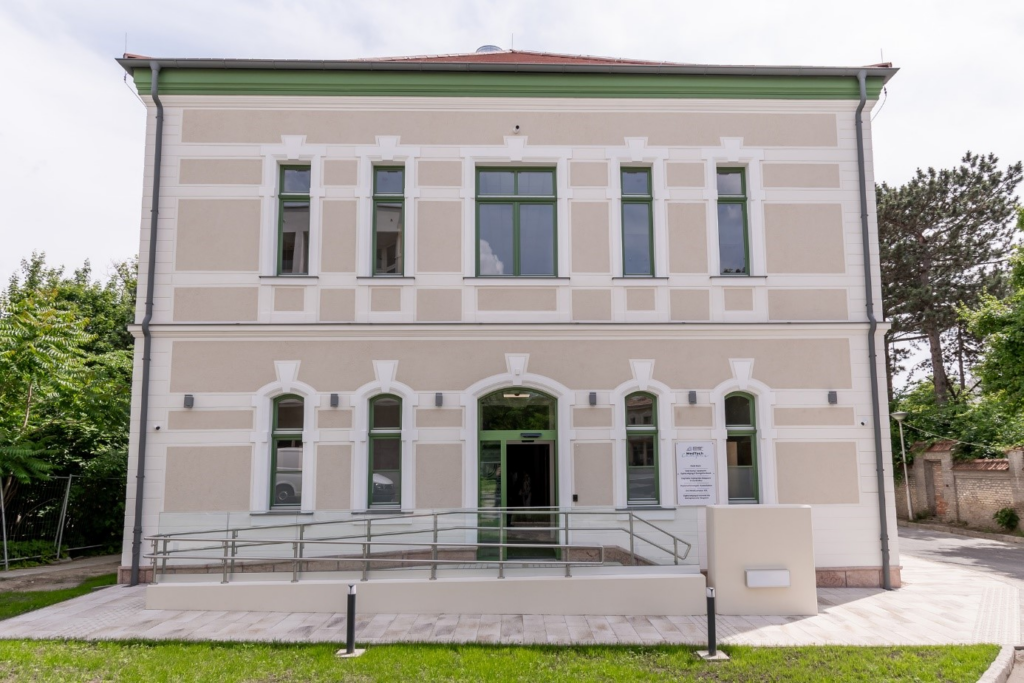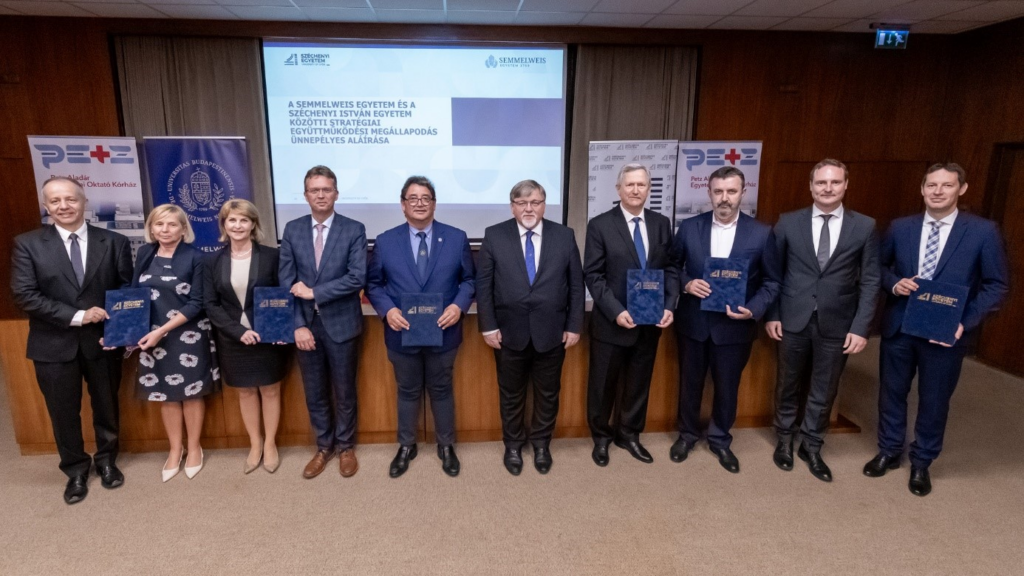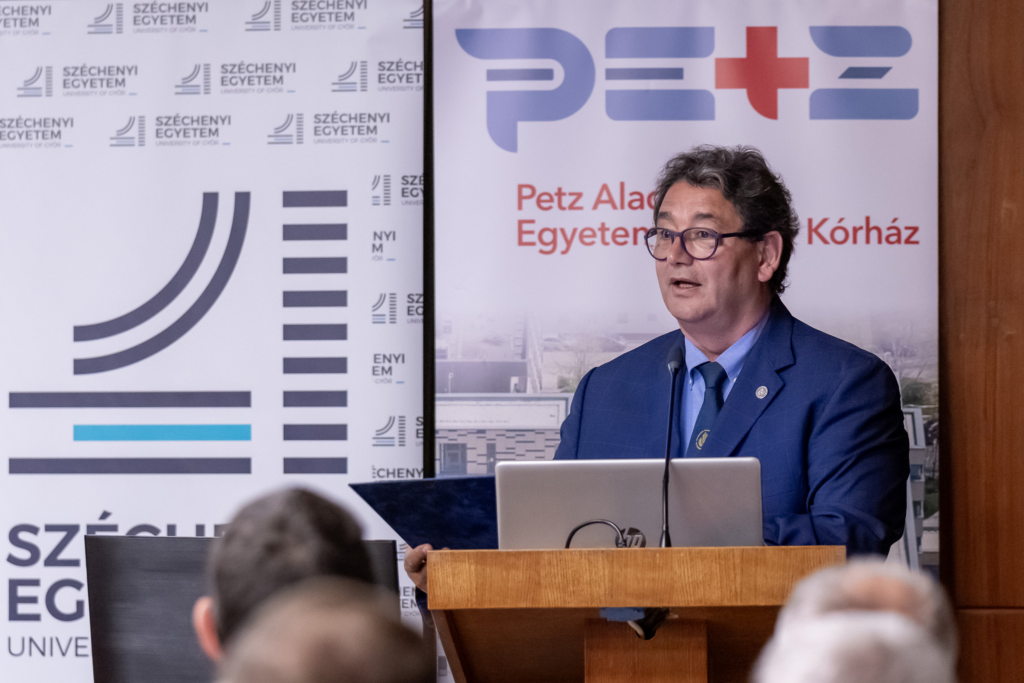SZE is implementing its MedTech Health Technology Campus in the former hospital complex in Zrínyi Street, Győr, the first completed building of which was inaugurated on 25 May. The facility will house a health technology incubator house, the country’s first Pető-Point outside the capital and it offers health services for university citizens. On the same day, the institution signed a partnership agreement with Semmelweis University.
Széchenyi István University took possession of the Zrínyi Street complex in November 2021. The institution is implementing its MedTech Health Technology Campus on the 2.7-hectare property, which consists of several buildings. The investment started with the reconstruction of the former Q-building, while the planning of the renovation of the other buildings is ongoing.
At the inauguration ceremony of the first completed building, Dr Bálint Filep, President of SZE, said that the institution will encourage new joint patents, innovations and health industry collaborations, while also contributing to the well-being of the people living in the region by providing quality services. „We also plan to continue the investment: the MedTech Campus will also include functions such as elderly care and rehabilitation, and will also host the training courses of our Faculty of Health and Sports Sciences. This will truly renew the former hospital complex on Zrínyi Street, both in terms of its content and its exterior, in line with the challenges of our time, thanks to the Government of Hungary and our strategic partners”, he said.

Dr Bálint Filep, President of Széchenyi István University (Photo: András Adorján)
Dr Csaba András Dézsi, Mayor of Győr, reminded that several iconic buildings in Győr have been completely renovated and given new functions thanks to the University’s involvement. „When the old biscuit factory was closed down, we did not imagine that today, with the creation of the university’s innovation park, a centre for industrial cooperation and research would be created in it. The same is true of this area, where not only are the former hospital buildings being renovated, but the combination of medicine, science and education is returning in an even higher quality,” he said.

Participants of the building’s opening. (Photo: András Adorján)
“It is good to see that the renewed higher education system is working in practice, permeating the city and the region like living tissue. The key elements are autonomy, flexibility, and competitiveness.” said Dr Balázs Hankó, State Secretary for Innovation and Higher Education. He said that this success is reflected in international university rankings and in the growing industrial revenues of higher education. He said the aim is for Hungary to be one of the ten most innovative countries in Europe by 2030, which is also the aim of the Neumann János Programme. „And innovation is university-led,” he stressed. The State Secretary named digitalisation, the green transition and healthy living as the focus of renewal. He pointed out that the cooperation between Széchenyi University and Semmelweis University is also forward-looking in this respect.

The development of the MedTech Campus of the Széchenyi István University started with the renewal of the former Q-building (Photo: András Adorján)
The renovated building was presented by Gabriella Szűcs, the managing director of Uni-Medicampus Kft., owned by the Győr-based institution. She said that the facility will provide health services for students and staff of the university. She added that the main objective of the MedTech Campus is to contribute to sustainability and technological development, which is why it will also serve as a base for health technology development and research. In cooperation with Semmelweis University, conductive pedagogical services will also be provided through the country’s first Pető-Point outside of the capital. In this context, Dr Andrea Zsebe, Dean of the András Pető Faculty at Semmelweis University, recalled 2022, when the two universities launched a joint programme on the subject. The establishment of the Pető-Point in Győr and the research that will make conductive development even more effective represent a new level of cooperation. „The launch of the Pető-Point in Győr creates an opportunity for a local conductor working at Semmelweis University, which guarantees professional quality, to be available to those in need, seeking advice and development,” he said.
On the same day, Széchenyi István University and Semmelweis University signed a cooperation agreement at the Petz Aladár University Teaching Hospital in Győr-Moson-Sopron County. Dr László Jávor, Director General of the hospital, hosted the event and praised the partnership between the two universities.

Participants of the signing ceremony of the cooperation between Széchenyi University and Semmelweis University (Photo: András Adorján)
Dr Zsolt Kovács, Vice President for General and Educational Affairs of Széchenyi István University and Dr Éva Feketéné Szabó, Vice Rector for Strategy and Development of Semmelweis University explained that the cooperation includes the implementation of joint training programmes, such as the Master’s degree in midwifery, as well as research and development cooperation by combining medical and health sciences and engineering sciences. The latter joint activities include research into medical technology, research into the application of artificial intelligence and digital imaging in healthcare, and the development of tools for the András Pető Faculty’s conductive education toolkit.
Dr László Palkovics, Chairman of the Board of Trustees of the Széchenyi István University Foundation, said that medical and engineering sciences build strongly on each other, and this is the basis for cooperation. „One of the future directions of Széchenyi University will be health science and health technology,” he said.
Dr Béla Merkely, Rector of Semmelweis University, said that any research that results in medical treatment will help the current and future generations to receive better healthcare and live healthier lives. He said: „Together we can achieve more than we can alone. I look to the future with optimism and hope that the cooperation between the two universities will be a model for all higher education institutions to follow.”

Dr Béla Merkely, Rector of Semmelweis University (Photo: András Adorján)






